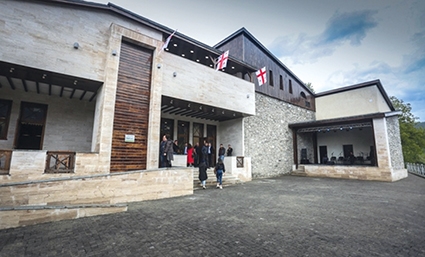Historic Sections of Mestia, Ushguli to be Renovated
The Georgian Ministry of Regional Development and Infrastructure has announced the next location in its plan for renovations of historic towns nationwide. The town of Mestia and the village of Ushguli have been targeted for rehabilitation and restoration works by the ministry.
Mesti and Ushguli are located in the Svaneti region. Mestia is the region’s largest town, with a year-round population of less than 2,000 people, and an elevation of 1,500 meters above sea level. Mestia is 128 kilometers northeast of Zugdidi, the nearest city. Ushguli is counted as one of the highest continuously inhabited settlements in Europe at 2,100 meters above sea level. For most of the year, the road connecting Ushguli to Mestia is unpassable, covered with snow and ice. Approximately 70 families call the isolated village home, many relying on income from businesses that cater to tourists who make the trek up, curious to see a glimpse of traditional Georgian high-mountain culture. Svaneti’s most distinguishing architectural feature is undoubtedly its stone towers, which were built attached to homes as a watch tower and defense mechanism. The Municipal Development Fund will restore several towers in both locations, focusing on the Lagami district of Mestia. The project will also renovate roads, install lighting systems, and construct a parking lot for visitors.
Earlier this week, the Ministry of Regional Development and Infrastructure announced the completion of another project in Mestia: the rehabilitation of the Leo Pilpani National and Folklore Theater. At the opening ceremony on Tuesday, Vice Premier, Minister of Regional Development and Infrastructure of Georgia Maya Tskitishvili, Executive Director of the Municipal Development Fund of Georgia (MDF) Giorgi Shengelia, Adviser to Prime Minister of Georgia Sozar Subari, and representatives of local authorities celebrated the center’s rebirth. The GEL 4.7 million ($1.68 mln) project was funded by the World Bank.
“This is a Culture Center that will serve as a home for the residents of Mestia and Svaneti, but first of all it will house the 90-year-old Ensemble ‘Riho.’ This is an ensemble with a great future and the renovated space will enable its numerous members to consider new plans and possibilities for expansion and development. The Folklore Center will be a cherished place not only for Mestia residents, but for its guests as well,” said Tskitishvili.
In an article written by Tskitishvili in April, published by The Economist in Georgia, she explains that “The MRDI strategically looks at Georgia’s history to identify potential development hot-spots, targeting old resorts…for renovation and revival, hoping to create a tourist-driven eco-system for a variety of businesses to thrive.” She adds, “Unfortunately, we are still busy building basic infrastructure in many settlements. There are villages where there are no internal roads or water,” however, “in addition to infrastructure, strong self-governance is necessary for the development of the regions.”
The ministry has several major rehabilitation projects planned, among them in Abastumani, Dusheti, Gudauri, and Kutaisi.
By Samantha Guthrie
Image source: Ministry of Regional Development and Infrastructure












